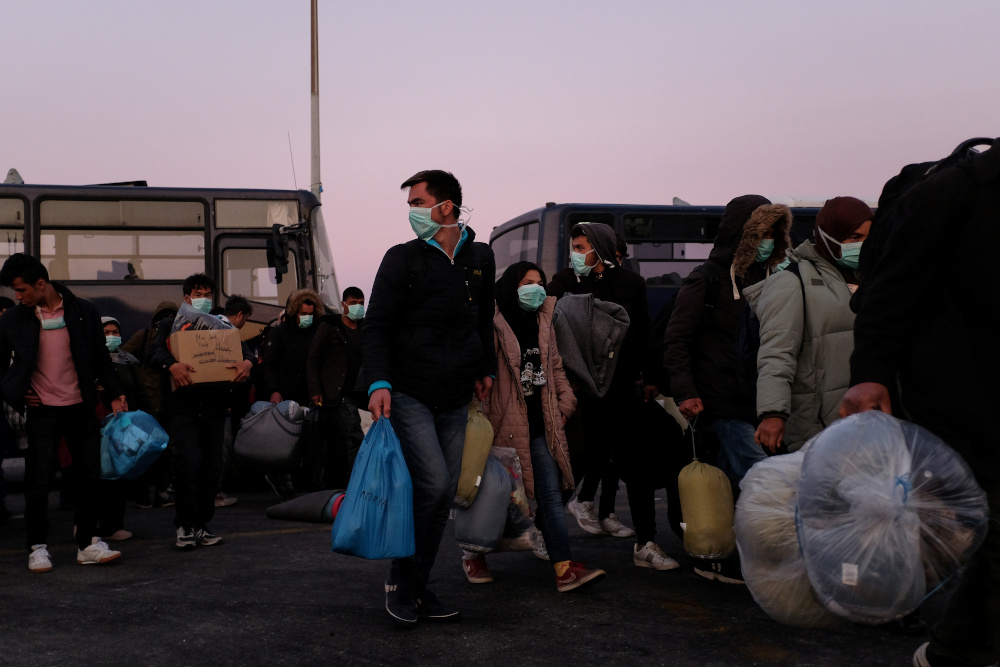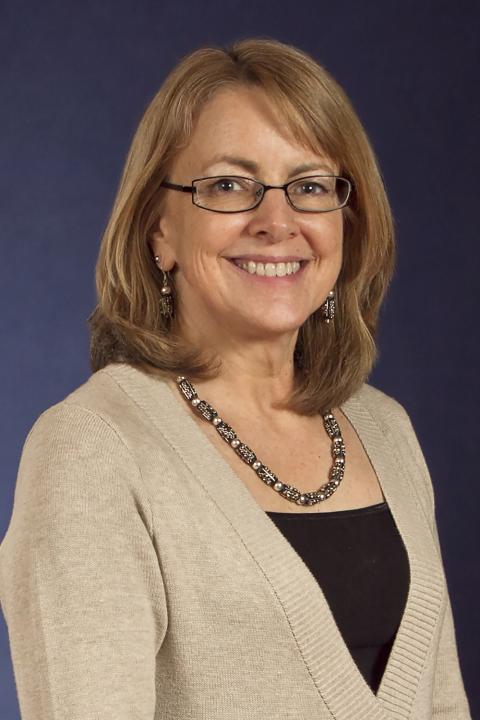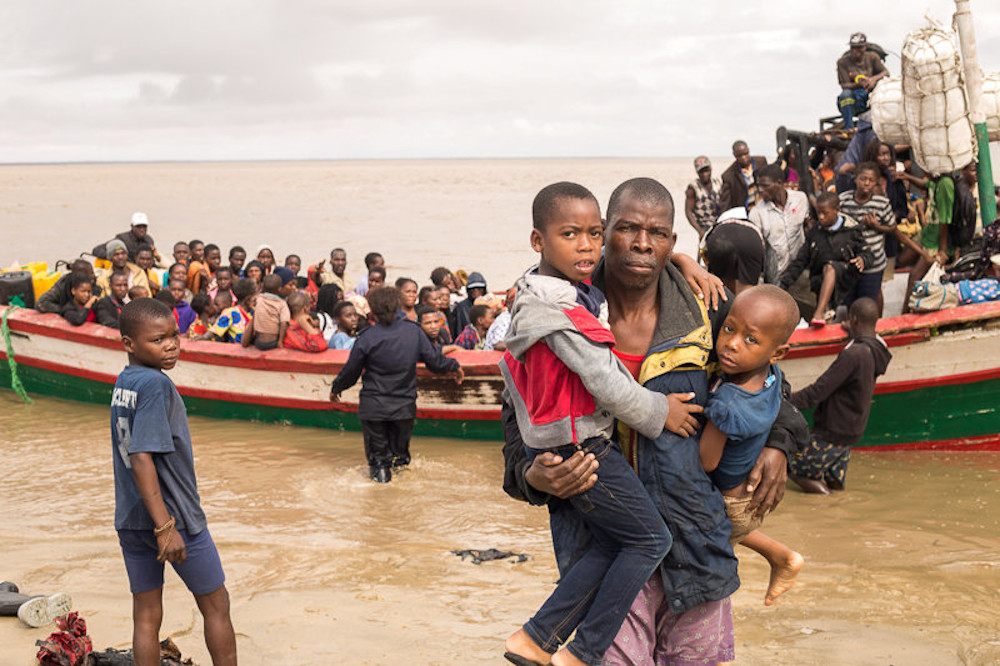
Migrants wearing protective face masks as a precaution against COVID-19 prepare to board a ferry to mainland Greece; they were at the port of Mytilene, on the island of Lesbos, March 20, 2020. (CNS/Reuters/Elias Marcou)
On June 20, known internationally as World Refugee Day, the world will celebrate the strength and courage of refugees around the world. This year, the vulnerability of refugees has been exacerbated by a global pandemic. Cramped living conditions and lack of access to vital resources put millions at extreme risk. In coming years, refugees will continue facing tremendous and unique challenges caused by yet another ongoing global crisis: climate change.
For refugees, climate change is what you'd call a "threat multiplier," says Joan Rosenhauer, executive director of Jesuit Refugee Service/USA.
As the leader of the U.S.-wing of an organization that served 1 in every 100 refugees worldwide in 2018, Rosenhauer knows well what kind of difficulties displaced persons are up against. In a June 19 interview with EarthBeat, she explained how the effects of climate change will not only lead to enormous numbers of displaced people in the future, but are also making life harder for refugees in the present.
"Imagine having fled your home after violence was imminent for you that threatened your life. You're grabbing your kids. You're fleeing. You're trying to settle into a home and place with almost no resources. You're living in a strange place with a mud hut. And then [imagine] having it all flattened by a storm," Rosenhauer said. "You've had to leave everything behind and you've lost everything already once, and now twice. It's those kinds of experiences where we see that climate change really multiplies the challenges that refugees face."
Below are excerpts from EarthBeat's discussion with Rosenhauer, edited for clarity and length. The conversation touches on terminology and legal definitions related to refugees, examples of how climate has displaced people and how Jesuit Refugee Service is tackling climate change. You can also watch the full interview at the top of the page.
EarthBeat: Why don't we start with some basic terminology? What is a climate refugee?
Rosenhauer: Well the term "climate refugee" is definitely used, but it actually doesn't have a technical definition and does not exist in international law. What that [term] means is someone who is displaced because of climate events. But, again, it doesn't have any status in international law, and that means that people who are displaced because of climate impacts don't have any protections under international law. This despite the fact that there are some estimates that suggest that 25 people every minute are displaced due to severe weather events such as floods and storms and droughts.

Joan Rosenhauer pictured in a 2012 photo. (CNS/courtesy Catholic Relief Services).
EarthBeat: What's the difference between a climate refugee and a climate migrant?
Rosenhauer: It's really similar to the difference between a migrant and refugee, and there are several terms that are worth discussing.
Migrant is used to describe people who are on the move for any number of different reasons – some forcibly and some not. It's a very broad term.
Refugee gets you into the focus on forcibly displaced people. And it's interesting that just yesterday, the UN released its latest data on forcibly displaced people and indicated that 79.5 million people are forcibly displaced around the world. That's a net increase in 2019 of nearly 9 million people who were forced to flee their home and are still displaced around the world. A refugee is someone who has fled their home and crossed an international border, and they have fled their home owing to a well-founded fear of being persecuted for reasons of race, religion, nationality, membership in a particular social group, or because of a political opinion. … So, when we talk about resettling refugees, we're talking about people who have gone through a formal process of being identified as a refugee. ... And the sad thing is for refugees, the U.S. has really dropped its commitment. In 2016, there were nearly 85,000 refugees resettled in the US. In 2020, the maximum limit is 18,000.
I want to say two other things about two other terms. One of them is an asylum seeker, and that is someone who is seeking these international protections that exist for refugees, but they have already arrived in the country in which they're seeking the protection. They may have already come into the country and then presented themselves for asylum, or they may present themselves at a border crossing.
Advertisement
And then there's a term that is getting a lot of attention these days because it's a very broad challenge: internally displaced people. Those are people who have been forced to flee their homes but they never cross an international border, and yet we know from what we see on the news that they are just as desperate. They're often in makeshift camps responding to terrible circumstances, and yet they don't they don't really get captured when you talk about a refugee.
EarthBeat: What are some examples of how climate and climate change have displaced people, whether they be refugees or internally displaced people?
Rosenhauer: Well, there are two key types of events that cause people to flee. One is the sudden onset of climate events that we often see people displaced due to extreme weather events such as cyclones or tsunamis, or droughts and things like that. This happens all over the world, but the challenge is [that] in the poorest nations for the poorest people, it's often very difficult for them to go back. It's not like they're displaced for a week and then they just go back. Once they've lost everything, they're stuck wherever they end up. And studies show that we are seeing more and more severe weather events as a result of climate change. In fact, the UN has indicated that every year – over and above the nearly 80 million people I mentioned before who are forcibly displaced – there's another 21.5 million people around the world who flee their homes because of a sudden onset weather event. And again, they are not covered by international protections. They would be citizens in their own country if they're an internally displaced person, but they still have lost everything and often really struggle.
The other type of impact the climate has on people that forces them to flee their home is the slow onset climate event, which would be rising average temperatures that lead to land no longer being fertile or rising sea levels that lead to coastal erosion. We see examples of this in Central America where farmers can no longer grow the crops they used to grow because of consistently rising temperatures. Another example would be sea level rise. ... There are projections that by 2100, 48 countries (mostly islands) around the world will be lost due to rising sea levels. Clearly those are all people who are going to have to leave their homes.
And the last thing I'd say is that we also recognize climate as what the UN General Secretary has called a threat multiplier. Often it plays a role in other kinds of crises that then lead people to be forcibly displaced. For example, there was a five year drought in Syria before the war broke out, and that contributed to some of the dynamics there and the level of strife there. There's a similar situation in South Sudan where there's a civil war going on. So, this idea that climate kind of accelerates other drives of forcible displacement is a very much recognized phenomenon.
EarthBeat: Another crisis that we're living through right now is the COVID-19 pandemic. What has been the impact of COVID on climate refugees and refugees more broadly?
Rosenhauer: Well, sadly violence and persecution don't stop for a pandemic. So the impact is really terrible on refugees and people who are fleeing because of a fear of violence and persecution. Because around the world countries have closed their borders, including the US, that means that these refugees have no access to the protection that they need. And, you know, that is certainly the case in the US. Over time in the last few months, and since the pandemic broke out, our asylum policies and other types of programs and protections have been shut down significantly.
But I'll say one other thing about how the pandemic is affecting refugees, which is that they are often in the most crowded, desperate situations. And we're watching [the disease] make its way around the world. We see it growing now in Latin America; there are projections that in Africa it's going to hit its peak between July and October. Often in these camps there's a long haul to try to get access to water. There is very little access to healthcare and very limited health care to protect themselves. So there's now more hand washing stations, there's isolation buildings for people who can track the disease, and a wide variety of things.
EarthBeat: What about climate change? What is the impact of climate change on current refugees who have been displaced by persecution or conflicts?
Rosenhauer: As I've said before, it is clearly recognized as a threat multiplier. The intersection between climate change and its impact on people and forcible displacement is clearly recognized. And what happens then is that people are just beaten down by repeated crises. I remember talking to a colleague of mine in Zimbabwe after Cyclone Idai. He said, basically: "Imagine having fled your home after violence was imminent for you that threatened your life. You're grabbing your kids. You're fleeing. You're trying to settle into a home and place with almost no resources. You're living in a strange place with a mud hut. And then [imagine] having it all flattened by a storm. You've had to leave everything behind and you've lost everything already once, and now twice." It's those kinds of experiences where we see that climate change really multiplies the challenges that refugees face.
EarthBeat: Looking towards the future then, as someone who works really closely on this issue, how do you expect climate change to continue impacting the lives of refugees?
Rosenhauer: I'm clearly very concerned about the long term impact because we're just not taking climate change seriously enough and we're not addressing it in a serious enough way to really put a halt to it. And therefore the impact is going to continue. The UN estimates that by 2050, up to 250 million people will be displaced by climate change impacts, such as rising sea levels and floods and famine and droughts. That's a huge number. We currently have 79.5 million people displaced. They're talking 250 million people by 2050 so it's clearly going to be a huge challenge.
It's [also] going to very much impact internally displaced people. Not everybody will cross a border, and so we have to help countries prepare to help their people. And we have to help the people who are in that situation now, and then build toward helping others as this happens so that they can mitigate their impact (though, in many cases, their impact is minimal). But also so that they can adapt as they need to. That's a real focus for us.
But I think for JRS/USA we also want to educate people so that as a culture globally we are going to attend more, and so those who have the biggest impact also make the biggest difference in slowing changes to our climate.
EarthBeat: That leads perfectly into my next question. In terms of priorities, you just mentioned education as one. So, from a humanitarian standpoint, what are JRS's biggest concerns in regards to climate change? And what initiatives are you taking to address those concerns?
Rosenhauer: Well the first thing I would say is we need to do a lot more than we are. And we need to really do an assessment of what we can do to make sure that we're doing as much as we can. So one thing would be education for people all over the world, in the countries where we serve – we serve in more than 50 countries around the world – so that they are aware of what they can expect in terms of climate events and how they can prepare. Preparedness is important. Adaptation is important, when they're finding that there's a change in weather patterns, higher temperatures, things like that. And then also to respond when the worst happens. ...
We do other kinds of work like reconciliation works. When people flee, they're often with people different from them. ... We want to help people adapt, both the refugee communities and host communities. ... All people who flee their homes have been through some kind of trauma, and if that goes unaddressed, it will haunt them the rest of their lives. That's true of adults, but children in particular, if they're not helped to address this definitely pay a price later in their lives. So we want to make sure that we address all of that so that as people are forced to flee their homes due to climate change, they're best equipped to rebuild their lives and lead a happier life.

Survivors of Cyclone Idai arrive at an evacuation center March 21, 2019, in Beira, Mozambique. Hundreds were feared dead in Mozambique four days after a cyclone slammed into the country, submerging entire villages and leaving bodies floating in the floodwaters, the nation's president said. (CNS/Red Cross Red Crescent via Reuters/Denis Onyodi)
EarthBeat: I saw that JRS signed onto the NGO Climate Compact. Could you tell me about what that is and why your organization signed up?
Rosenhauer: Sure. It is a compact initiated by an organization called InterAction, which is an association of many international non governmental organizations in the US, and many operate other places but that have a connection to the US and to DC. The compact was signed by more than 80 of their members and its purpose is to really make a collective statement about the direction that we all need to go over the next two years to address climate change and to codify commitments in several key areas. In our organization, one is our education, advocacy, public awareness building, things like that. Another is our programming around the world, making sure that we're attentive to climate change in all of our programs, our international operations at our headquarters and in our field offices; making sure that we look at our attendance to protecting the environment in all the things that we do. And then finally learning for ourselves that we're constantly learning and keeping each other aware so that we can do the most we can.
JRS signed on because of church teaching about character creation and Laudato Si' and everything that the Holy Father has said about the importance of caring for the environment. But also, as a Jesuit organization, we signed on because of the universal apostolic principles, the fourth of which is caring for God's creation. And so for us this is a part of our mission, both its roots in Catholic teaching and Jesuit priorities, and then also because of just the general commitment to care for the most vulnerable. They will be impacted in very severe ways by climate change.
[Jesse Remedios is a staff writer for NCR's EarthBeat. His email address is jremedios@ncronline.org. Follow him on Twitter @JCRemedios]







